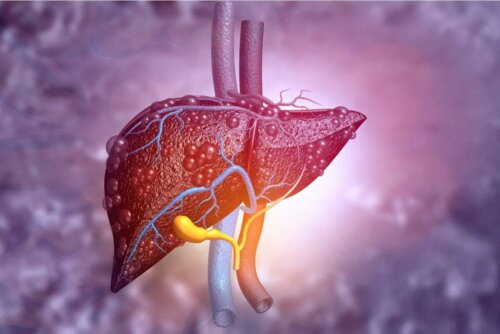Foods that People with Cirrhosis Should Eat


Written and verified by the nutritionist Florencia Villafañe
The foods that people with cirrhosis should eat depend on the stage of the disease they’re going through. Taking into consideration that it has no cure, setting long-term goals is a priority, since they must be sustained for years.
This pathology is the end result of chronic liver damage. According to the American College of Gastroenterology, about 5.5 million people in the United States suffer from it. Believe it or not, this condition causes around 26,000 deaths a year approximately.
Cirrhosis, what exactly is it?
Cirrhosis is a chronic condition in which cells die in certain areas of the liver, resulting in fibrosis (a kind of scar). Thus, nodules replace liver tissue, which leads to an alteration in the architecture and functionality of the organ.
According to several pieces of research, one of the main causes of this pathology is the excessive consumption of alcohol. Secondly, we have a biliary obstruction, chronic hepatitis B or C, and other liver diseases. It’s very important to learn its different causes, for example, alcoholics wouldn’t get the same diet as other patients.
Read also: Five Homemade Drinks to Detox the Liver
The stages of the disease
There are two basic stages in regard to this condition. The initial one is known as compensated cirrhosis. Then, without any treatment or approach, advanced or decompensated cirrhosis occurs, which is when cell destruction is maintained over time. The diet must be extremely rigorous in the latter stage since it’s where the following symptoms arise:
- Jaundice. This is the yellowing of the skin and mucous membranes due to the elevation of bilirubin.
- Ascites. This is the accumulation of fluid in the abdomen due to changes in the internal pressure of the blood vessels.
- Encephalopathy. This produces mental confusion after toxic substances are present in the brain.
- Digestive hemorrhages.
Malnutrition prevalence
Malnutrition is a very common sign in these patients. Several studies suggest that up to 25% of compensated cirrhotics and 80% of advanced patients suffer from it. In general, there’s a loss of muscle mass (greater in men) and of adipose tissue.
In alcoholics, malnutrition is even greater. On one hand, we have the deleterious effects of liver disease. However, we must add the lack of variety in the foods consumed due to the bad habits of addiction.
Foods that people with cirrhosis should eat
In general, patients get their cirrhosis diagnosis when the disease is already advanced. For this reason, the main dietary goal is to provide the nutrients they need to avoid deficiencies. Additionally, people who have this disease should follow a hepaprotective diet at all times.
Thus, the piece of study Nutritional Care for Patients with Liver Cirrhosis shows that those who have compensated cirrhosis and are stable tend to have quite normal requirements. Therefore, the diet must provide all food groups and be low in fat.
According to the Spanish Society of Digestive Pathology, the following must be included in it:
- White and red meats (it’s important to prioritize low-fat options)
- Fish
- Eggs
- Fruit and vegetables
- Cereals
- Crude oils (in moderation)
- Nuts (in limited quantity)
- Seeds
- Skim dairy

In the same way, each particular case must undergo a thorough evaluation. Research in this field indicates that, in order to avoid deficiencies, the protein intake should cover from 1 to 1.5 grams per kilogram (2 lb) of weight. Likewise, specialists suggest having 5 lightweight meals a day.
In addition, all toxic substances (including alcohol, of course) must be completely eliminated from the diet. In fact, when alcohol abuse is the cause of this pathology, its elimination slows the progression and improves the prognosis in a remarkable way.
Read also: The effects of alcohol in the body
Eating when there are express symptoms of the disease
The aforementioned complications appear in the decompensated phase. In it, the foods that people with cirrhosis should eat are reduced. Therefore, according to an article published in the Farmacia Profesional magazine, the diet must be catered to their needs. It’s important to consider the following:
- Limiting fluid intake to 1.2 liters a day.
- Restricting sodium intake since it favors the accumulation of fluids and aggravates ascites.
- Reducing protein consumption in order not to overload the liver, which is the main tissue in charge of metabolizing them.
Protein restriction can be from 0.5 grams per kilogram of weight in patients with encephalopathy. Then, they can gradually increase the value until reaching a normal level. If the patient decides to take this measure, no matter how minimal it may be, it’s necessary for them to consume supplements with branched-chain amino acids to avoid further damage.
Also, the introduction of vitamin complexes can be considered – vitamins B and K are especially necessary. The first prevents the evolution of neuropathies and the second reduces bleeding episodes that result from coagulation failure.

The liver transplant option
Patients with advanced disease may consider liver transplantation as a treatment option. However, it’s important to remember that the surgery carries great risks and that it’s not really the definitive solution considering how intense the aftercare is.
Likewise, those who get to this stage need to take medications to keep their body from rejecting the new organ. Nonetheless, these drugs have adverse effects, many of them hepatic.
Food that people with cirrhosis should eat, things to remember
No matter if the cirrhosis is stable or unstable, the liver’s activity is always deficient, which causes toxic substances to accumulate in the body. Therefore, in order to avoid any kind of complications, it’s vital to be strict with the diet at all times
The ideal thing would be to keep controls with a medical and nutrition professional to evaluate the general condition and indicate the most appropriate diet for the individual. Likewise, the use of drugs will be necessary since the complexity of the disorder doesn’t admit a single approach.
All cited sources were thoroughly reviewed by our team to ensure their quality, reliability, currency, and validity. The bibliography of this article was considered reliable and of academic or scientific accuracy.
- Aceves-Martins, M. (2014). Cuidado nutricional de pacientes con cirrosis hepática. Nutrición Hospitalaria, 29(2), 246-258.
- Kalaitzakis, E., Simrén, M., Olsson, R., Henfridsson, P., Hugosson, I., Bengtsson, M., & Björnsson, E. (2006). Gastrointestinal symptoms in patients with liver cirrhosis: associations with nutritional status and health-related quality of life. Scandinavian journal of gastroenterology, 41(12), 1464-1472.
- Román Abal, E. M., & de Patología, A. E. D. E. (2007). Guía de cuidados para pacientes con cirrosis hepática y sus familiares.
- Buey, L. G., Mateos, F. G., & Moreno-Otero, R. (2012). Cirrosis hepática. Medicine-Programa de formación médica continuada acreditado, 11(11), 625-633.
- Gaviria, Mónica Marcela, Gonzalo Correa Arango, and María Cristina Navas. “Alcohol, cirrosis y predisposición genética.” Revista Colombiana de Gastroenterología 31.1 (2016): 27-35.
- Fernández, Marlen Ivón Castellanos. “Nutrición y cirrosis hepática.” Acta Médica de Cuba 11.1 (2003).
- Mesejo, A., M. Juan, and A. Serrano. “Cirrosis y encefalopatía hepáticas: consecuencias clínico-metabólicas y soporte nutricional.” Nutrición Hospitalaria 23 (2008): 8-18.
- Ruiz-Margáin, A., et al. “Manejo dietético y suplementación con aminoácidos de cadena ramificada en cirrosis hepática.” Revista de Gastroenterología de México 83.4 (2018): 424-433.
- Vilas-Rivas, María José, et al. “Recomendaciones al alta para pacientes diagnosticados de cirrosis.” ICUE. Investigación y CUidados de Enfermería 2.2 (2017): 45-49.
This text is provided for informational purposes only and does not replace consultation with a professional. If in doubt, consult your specialist.








